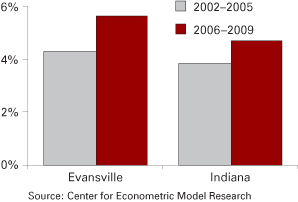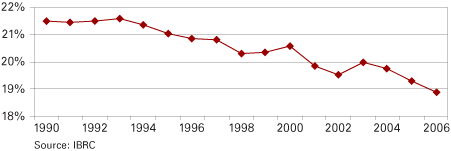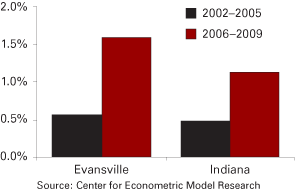Evansville
Professor of Economics; Dean of Business, College of Business, University of Southern Indiana, Evansville
The Evansville economy continues to exhibit positive year-over-year growth. In 2007, personal income is estimated to increase by 5.6 percent compared to an average annual growth rate of 4.3 percent between 2002 and 2005 (see Figure 1). Economic performance in 2007 was driven by job creation in private service-providing industries, which outweighed weakness in manufacturing and retail trade. The manufacturing sector continues to be an important base to metro area household incomes and consumer spending activity, even as the economy diversifies away from manufacturing-industry dependence (see Figure 2).
Figure 1
Average Growth in Personal Income

Figure 2
Manufacturing Employment as a Percent of Total Nonfarm Employment in the Evansville Metro

During 2007, construction payrolls continued to grow despite evidence of a slowing housing market, deteriorating credit quality, and higher delinquency rates. Single-family housing starts have declined by more than 20 percent year-over-year. Existing home prices declined from an average of $100,300 in 2006 to $98,300 in 2007. Mortgage originations also dropped from $1.6 billion in 2006 to $1.5 billion in 2007, while personal bankruptcies per 1,000 persons increased from 3.1 to 5.7.
Although the Evansville economy is one of the most manufacturing-dependent among metro areas in the nation, it has not experienced the same degree of hardship as other manufacturing-dependent Midwest metro areas. Since 2000, Evansville's manufacturing workforce has fallen by 7 percent, or about 2,600 workers. Compare that to the 14.7 percent reduction in Indiana's manufacturing workforce over the same period. At the same time, manufacturing earnings as a share of total earnings has remained stable at about 28 percent between 2001 and 2006 in the Evansville metro economy. The growth of the auto industry, headed by top employer Toyota, partly explains the resiliency of Evansville's manufacturing sector. The strong demand for primary metals in recent years, which has kept Alcoa among the largest local employers, has also aided Evansville's resiliency.
Current efforts to attract future high-tech related industries, via the creation of a downtown technology park, an emphasis on workforce development, and relatively low office rents (that average $50 below those nationally), are sources of momentum for economic expansion. The outlook forecasts increased momentum in the Evansville metro economy as a result of hiring and investment activity in the service sector.
In 2008, we project that output will increase by 2.1 percent, the number of jobs will increase by 1,600, and personal income will grow 4.3 percent. Figures 1 and 3 provide a comparison of forecasts for the Evansville economy and the state of Indiana for the 2006–2009 period.
Figure 3
Average Growth in Total Employment

Ongoing challenges for the Evansville economy include adjustment away from manufacturing-industry dependence, particularly in nondurable manufacturing (see Table 1), an elderly age cohort as a proportion of the population that is higher than the state average, and relatively slow population growth—below the state and national average.
Table 1
Manufacturing Employment as a Percent of Total Employment, 2006
| Industry | Evansville Metro |
Indiana |
United States |
| Manufacturing | 19.0 | 19.0 | 10.4 |
| Durables | 54.1 | 73.3 | 63.4 |
| Nondurables | 45.9 | 26.7 | 36.6 |
Source: IBRC
Also in this Issue…
- Outlook for 2008
- The International Economy
- The U.S. Economy
- Financial Forecast
- Housing
- Indiana Agriculture
- Indiana
- Anderson
- Bloomington
- Columbus
- Evansville
- Fort Wayne
- Gary
- Indianapolis-Carmel
- Kokomo
- Louisville
- Muncie
- Richmond
- South Bend-Mishawaka and Elkhart-Goshen
- Terre Haute
- Return to Table of Contents



